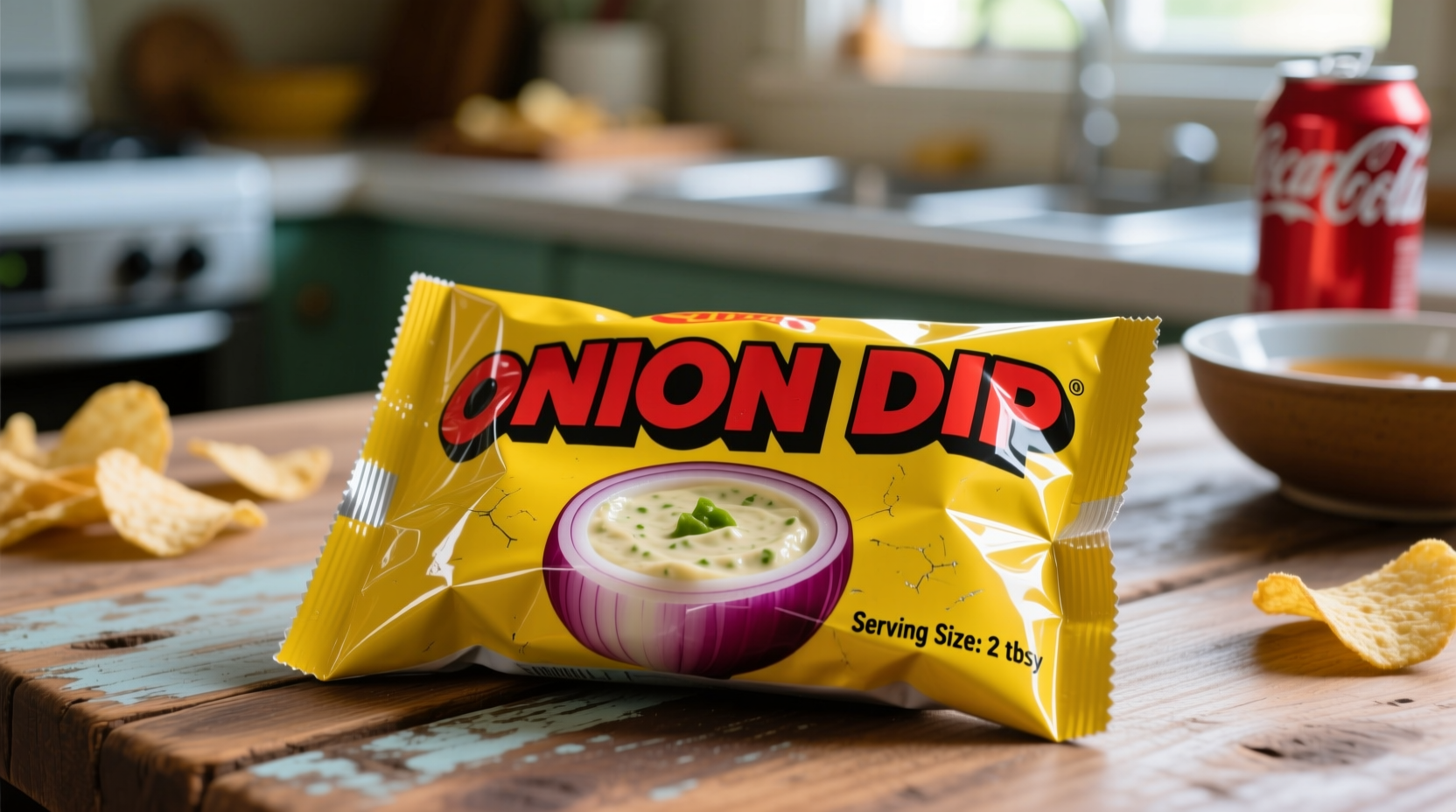Discover how this pantry staple can transform from basic chip dip to gourmet sauce ingredient, marinade component, and flavor booster for multiple dishes. Learn proper measurements, storage techniques, and creative recipes that go far beyond the snack bowl.
What Exactly Is in an Onion Dip Packet?
Most commercial onion dip packets contain a consistent blend of ingredients designed for quick preparation. According to the USDA FoodData Central database, a standard 1-ounce (28g) packet typically includes:
| Ingredient | Typical Percentage | Purpose |
|---|---|---|
| Dehydrated onion flakes | 45-55% | Primary flavor base |
| Salt | 20-25% | Flavor enhancer and preservative |
| Monosodium glutamate (MSG) | 5-10% | Umami booster (not in all brands) |
| Modified food starch | 8-12% | Thickening agent |
| Garlic powder | 3-5% | Flavor complexity |
| Spice extracts | 2-4% | Additional flavor notes |
This standardized composition explains why most brands deliver remarkably similar results despite marketing differences. The consistency makes them reliable for recipe development when you need predictable flavor outcomes.
How to Use Onion Dip Packets: Beyond the Obvious
While the classic preparation involves mixing one packet with 1 cup of sour cream or mayonnaise, professional chefs like Antonio Rodriguez recommend these additional applications:
As a Dry Rub for Proteins
"Don't limit onion dip packets to wet preparations," advises Rodriguez. "They make excellent dry rubs for chicken, pork, or even roasted vegetables. Simply mix one packet with 2 tablespoons of olive oil to create a paste that adheres to proteins before cooking." This technique works particularly well for sheet pan dinners where you want consistent flavor distribution.
Flavor Booster for Soups and Stews
Add half a packet to tomato-based soups or beef stews during the last 15 minutes of cooking. The dehydrated onions reconstitute while adding depth without altering the dish's texture. This method works especially well for weeknight meals when you need to enhance store-bought broths.
Quick Sauce Base
Combine one packet with 1/2 cup Greek yogurt and 2 tablespoons of buttermilk for an instant salad dressing or vegetable dip. For a richer version, substitute mayonnaise for half the yogurt. This creates a lower-calorie alternative to traditional sour cream-based dips while maintaining the signature onion flavor.

Nutritional Profile and Dietary Considerations
According to USDA FoodData Central, a standard prepared onion dip (one packet mixed with 1 cup sour cream) contains approximately:
- Calories: 280 per serving (2 tablespoons)
- Sodium: 320mg (14% of daily value)
- Carbohydrates: 6g
- Protein: 2g
- Fat: 26g (mostly from the sour cream or mayonnaise)
The sodium content varies significantly between brands, with some premium "reduced sodium" versions containing up to 30% less salt. For those monitoring sodium intake, consider using half a packet and supplementing with fresh minced onion to maintain flavor while reducing sodium by approximately 40%.
Storage Guidelines and Shelf Life
Unopened onion dip packets maintain quality for 12-18 months when stored in a cool, dry pantry. Once opened, transfer unused portions to an airtight container where they'll remain flavorful for 3-4 months. The USDA Food Safety and Inspection Service recommends discarding any packet showing signs of moisture, clumping, or off-odors, as these indicate potential spoilage.
When preparing dip, consume within 3-4 days when stored in the refrigerator. The dairy component determines the shelf life, not the packet itself. Always use clean utensils when serving to prevent bacterial contamination that could shorten the dip's safe consumption period.
10 Creative Recipe Ideas Using Onion Dip Packets
1. Onion Dip Deviled Eggs
Replace traditional mustard with prepared onion dip in your deviled egg filling for a savory twist. The creamy texture and onion flavor complement the egg perfectly.
2. Loaded Baked Potato Topping
Mix one packet with 1/2 cup shredded cheddar and 1/4 cup crumbled bacon. Spoon over baked potatoes and broil until bubbly for an instant loaded potato.
3. Quick Meatloaf Glaze
Combine one packet with 1/4 cup ketchup and 1 tablespoon brown sugar. Brush over meatloaf during the last 20 minutes of baking for a flavorful crust.
4. Onion Dip Popcorn Seasoning
Mix one packet with 2 tablespoons melted butter and spray over freshly popped popcorn. Toss thoroughly for instant savory popcorn.
5. French Onion Soup Shortcut
Add one packet to 4 cups of beef broth with sliced onions. Simmer 20 minutes, then top with toasted baguette slices and melted Gruyère for a 30-minute French onion soup.
6. Onion Dip Burger Sauce
Mix one packet with 1/2 cup mayonnaise and 1 tablespoon relish for a gourmet burger spread that elevates ordinary patties.
7. Instant Gravy Base
Whisk one packet into 2 cups of pan drippings or broth with 2 tablespoons flour for a quick onion-flavored gravy.
8. Onion Dip Pasta Salad
Combine prepared dip with cooked pasta, cherry tomatoes, and diced cucumbers for a creamy pasta salad ready in minutes.
9. Onion Dip Roasted Vegetables
Toss vegetables with olive oil, then sprinkle with dry dip mix before roasting for caramelized onion flavor without added moisture.
10. Onion Dip Pizza Base
Spread prepared dip on pizza crust instead of tomato sauce, then top with mozzarella, bacon, and red onions for a white pizza variation.











 浙公网安备
33010002000092号
浙公网安备
33010002000092号 浙B2-20120091-4
浙B2-20120091-4